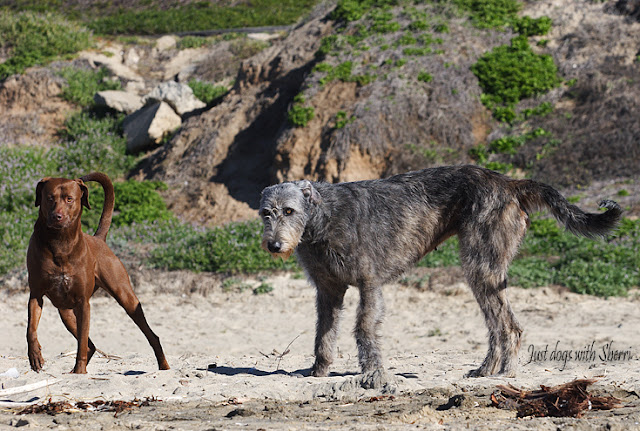Over the years I've had the chance to handle, train and photograph some giant breeds. There is no criteria to make the "giant" category but more a list of who should be on it. Of course the tallest breed is the Irish Wolfhound, a sweet and wonderful breed that I love. Their grayish wirey coat with scruffy eyebrows gives them a character all their own. They are quite a gentle breed, quiet and calm normally. I have photographed several, one shoot took place at the beach where this tall gal ran into the beach bully. The bully thought twice when he got close up. I love this image, the face on the bully says it all. "Oooops, sorry madame."
Some of the dogs that fit the giant category are:
Irish Wolfhound
Great Dane
Kangal Dog
Scottish Deerhound
Newfoundland
English Mastiff
Saint Bernard
Great Pyrenees
Neapolitan Mastiff
Greater Swiss Mountain Dog
Leonberger
Caucasian Shepherd Dog
Borzoi
Kuvasz
Anatolian Shepherd
Tibetan Mastiff
The lifespan of the giant breeds is often very short. There is no one pinpointed reason why larger dogs live shortened lives but the fact that their body carries around so much and functions harder just on a regular basis is commonly the sad truth. Their bodies suffer from far more wear and tear than the smaller versions. Their organs must work harder to keep them going and thus wear out earlier.
The tallest dog at the moment is Giant George, a 43" blue male Great Dane. The heaviest dog which was last recorded as Kell, but before her was Hercules, both are English Mastiffs. Sadly this record can be altered simply by over feeding a dog so I believe it should only be done on dogs that are deemed fit. But the fact remains, the larger the dog the shorter the lifespan, sad. Of course this is not an absolute, there are many big whoppers who are well into their teens, it is just the general average.
I have worked with Great danes much smaller than the giant versions who were 10-12 years of age and doing wonderfully. Breeding for bigger and bigger sized dogs only harms the dogs we love as does breeding tiny little tea cup sized dogs. I think if people who breed these dogs focused on health and longeivity more than height the dogs could have their life expectancy extended, which would be a great thing. Of course not everyone is breeding for size, those are few and far between thankfully and many giant breeds are living much longer than they ever use to.
Most of the real giant breeds have wonderful temperaments, this has be accomplished by years of dedicated work on improving temperament. No one wants to deal with a 250 lb aggressive dog right? And many of the giant breeds decended from fighting dogs used as guards or hunting. So cleaning up the temperament was imperative to live in todays society and they have accomplished that.
Feeding giant breeds has changed as well. Way back people simply pumped extra calcium and protein into these guys as they were growing. People figured that they had so much growing to do that they best supply them with lots of stuff to grow on. This caused much damage as they grew at disproportionate stages. There is much information about feeding giant breeds now and this is one source I have found. The Great Dane Lady.
Each giant breed has their own list of genetic problems which can typically be found on the National Breed site club pages. It is worth while to do some research so that you know what type of issues may arise down the road. I love giant breeds, they stand statuesque and regal, canine art. But like other breeds, they have their own set of issues that you should know about. If you are considering a giant breed, educate yourself on the size specific issues.






No comments:
Post a Comment
Love to hear from you.